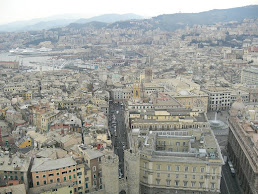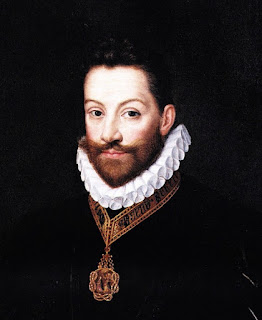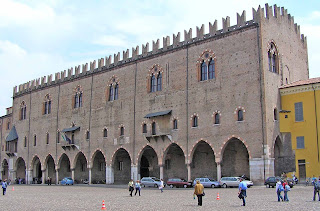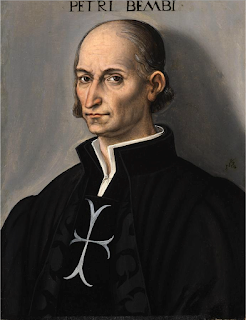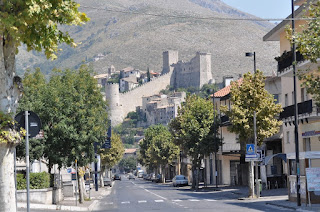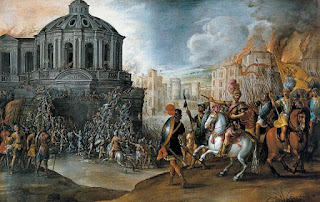Calamitous papacy of a vacillating Medici
Giulio di Giuliano de’ Medici, remembered as the unfortunate Pope who was imprisoned in Castel Sant’Angelo in Rome, was elected on this day in 1523 as Pope Clement VII.
Pope Clement VII, captured by Sebastiano
del Piombo, complete with beard
Clement VII also went down in history for refusing to allow the King of England, Henry VIII, to annul his marriage to Catherine of Aragon, causing England to break away from the Catholic Church forever.
One month before Giulio de Medici’s birth, his father was murdered in Florence Cathedral in what is referred to as the Pazzi conspiracy. His mother is believed to have been Fioretta Gorini, the daughter of a university professor, and Giulio was born illegitimately in May 1478 in Florence.
Giulio spent the first seven years of his life living with his godfather, the architect Antonio da Sangallo, the Elder. Then Lorenzo the Magnificent took over, raising him as one of his own sons, alongside Giovanni, the future Pope Leo X, Piero and Giuliano. Young Giulio received a humanist education at Palazzo Medici and became an accomplished musician. He studied canon law at the University of Pisa and accompanied his cousin, Giovanni, to the conclave of 1492 when Rodrigo Borgia was elected Pope Alexander VI.
 |
| Titian's portrait of the Holy Roman Emperor, Charles V |
Following the death of Pope Leo X in 1521, Cardinal Giulio was expected to succeed him, but the College of Cardinals elected Pope Adrian VI, who was from the Netherlands.
Cardinal Giulio was influential throughout Adrian’s 20-month reign, splitting his time between Palazzo Medici in Florence and Palazzo della Cancelleria in Rome.
After Adrian’s death in 1523, Giulio finally succeeded in being elected Pope Clement VII in the conclave of 19 November.
During his reign there were many political, military and religious struggles that were to have far-reaching consequences for Christianity.
The protestant reformation was spreading, the Catholic Church was nearing bankruptcy and foreign armies were invading Italy. Clement VII started out by trying to unite Christendom and liberate Italy from foreign occupation.
Europe’s two most important rulers, the Holy Roman Emperor Charles V and King Francis I of France, both demanded that Clement VII should choose to take their side.
 |
| Michelangelo's extraordinary Last Judgement, commissioned by Clement VII just before he died |
Clement VII escaped through a covered passageway to Castel Sant Angelo, where he remained imprisoned for six months before he was able to escape in disguise and take shelter in Orvieto and Viterbo. While imprisoned, he had grown a full beard, which he kept for the rest of his life, setting a fashion that the next 25 popes who came after him were to follow.
After Clement VII returned to Rome, he agreed to crown Charles V as Holy Roman Emperor in Bologna. This was to be the last time a Holy Roman Emperor was crowned by a Pope.
When King Henry VIII asked Clement VII to annul his marriage to Catherine of Aragon, Clement refused because Catherine was the aunt of Charles V, who he daren’t offend. His refusal led to England becoming a protestant country.
A few days before his death in 1534, Clement VII, who had been a great patron of the arts, commissioned Michelangelo to paint the Last Judgment on a wall in the Sistine Chapel.
Clement VII died in September 1534, aged 56. His body was interred in St Peter’s Basilica and later transferred to a tomb in the Choir of Santa Maria sopra Minerva in Rome.
Travel tip: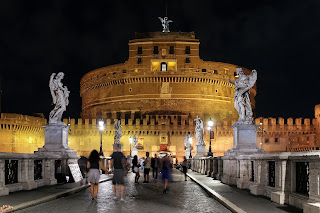
Castel Sant'Angelo on the banks of the Tiber,
illuminated at night
Castel Sant’Angelo was originally built as a mausoleum for the Roman Emperor Hadrian and his family on the right bank of the Tiber between 134 and 139 AD. There is a legend that the Archangel Michael appeared on top of the mausoleum, sheathing his sword as a sign of the end of the plague of 590, which is how the castle acquired its present name. Pope Nicolas III commissioned a covered fortified corridor, the Passetto, to link it to the Vatican and Pope Clement VII was able to use it to escape from the Vatican during the siege of Rome by Charles V’s troops in 1527. Castel Sant’Angelo was used as the setting for the third act of Giacomo Puccini’s 1900 opera Tosca, during which the heroine leaps to her death from the ramparts.
Travel tip:
The church of Santa Maria sopra Minerva,
where Pope Clement VII is buried
The Church of Santa Maria sopra Minerva, which houses Clement VII’s tomb, is on the opposite side of the Tiber from the Vatican in Piazza della Minerva off Via Minerva, south east of the Pantheon. It is the only Gothic church in Rome. The first Christian church on the site was built directly above, (sopra), a temple dedicated to the goddess Minerva. The present structure was built in 1280 by the Dominicans. The tombs of both Leo X and Clement VII are in the church, both designed by the Renaissance sculptor Baccio Bandinelli in 1541.
Also on this day:
1877: The birth of Venice Film Festival founder Giuseppe Volpi
1893: The birth of boxer Giuseppe Curreri, aka Johnny Dundee
1907: The birth of Olympic champion Luigi Beccali
1926: The birth of neo-fascist politician Pino Rauti
